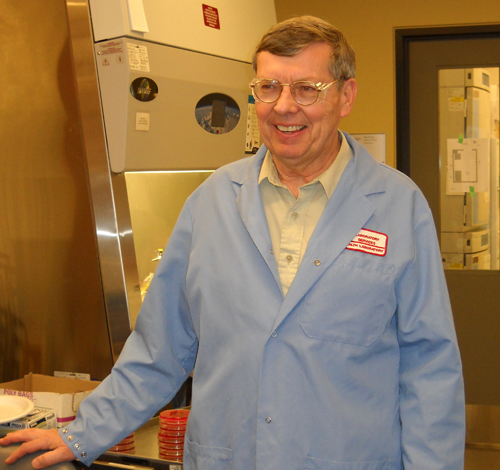
Grant Maxie is motivated to come to work every day by things that would make others want to stay home: avian influenza, Q fever, H1N1 and West Nile virus, to name just a few.
The challenge of identifying, monitoring and testing for new and emerging diseases is what makes the director of U of G’s Animal Health Laboratory (AHL) keen to get to campus each morning ─ even after 40 years.
These days, he has a larger, newer and shinier “office” to come to as well. In October, the University officially opened the Pathobiology – Animal Health Laboratory building, a $62-million, four-storey, 126,000-square-foot hub for investigating diseases and solving animal and public health problems.
About one- third of the building is dedicated to AHL, which provides specialized diagnostic services for veterinarians and public- and private-sector clients as a partner in the Ontario Animal Health Surveillance Network with the Ontario Ministry of Agriculture, Food and Rural Affairs (OMAFRA).
Already recognized internationally as a leader in detecting and controlling infectious pathogens, AHL is now even better and stronger. Its testing and detection equipment is state-of-the-art, and its new laboratories are better configured and more elaborate.
Strolling along the hallways of the laboratory, which occupies the first and second floors of the new building, Maxie resembles a proud new father. “We have unique technology that distinguishes us, making us the most sophisticated veterinary diagnostic lab in Ontario.” There are open-concept laboratories that encourage cross-training. “The idea is that you can see what your colleagues are doing and share tasks and technology better.”
Specialized areas allow for detecting foreign animal diseases, testing for TSEs (rare degenerative brain disorders called transmissible spongiform encephalopathies), and performing a variety of enzyme-linked immunosorbent assays (ELISAs).
Cutting-edge machines do everything from determining causes of animal disease to characterizing viral gene sequences.
The building affords improved biosecurity and biocontainment too, especially for the postmortem suite and its enhanced containment labs. “Tighter security means we can deal better with bad bugs,” Maxie says. “We are not tracking anything in, and we are not taking anything home.”
Of course, it’s not just “new house” pride that has him so enthusiastic. Rather, he knows that this is where the next disease outbreak will be monitored, an emerging pathogen detected, or a potentially dangerous disease prevented. “There is always something new emerging. We’re always in the front line ready to detect and help understand these challenges,” he says.
Among past challenges, AHL has monitored mad cow disease and rabies, provided expertise on zoonotic agents such as influenza A virus, and even helped solve a major international mystery. In 2007, tests conducted in AHL’s Laboratory Services helped explain how melamine-contaminated pet food was killing dogs and cats in North America. “That was a big event,” Maxie says.
He has led the laboratory since it moved to U of G in 1997 under the University’s enhanced partnership with OMAFRA. He oversees a staff of about 100 full- and part-time employees, including 17 veterinarians, all working as a team to provide excellent client service.
The Animal Health Laboratory is in the third year of a five-year, $7.5-million OMAFRA strategic investment in animal health that has supported more than 40 research and development projects. “It’s a big investment that has given us plenty of opportunity to move forward,” he says. OMAFRA also provided $25 million toward the new building.
Maxie came to Guelph in 1969 as a 23-year-old grad of the Western College of Veterinary Medicine in Saskatchewan. His subsequent PhD in clinical pathology took him to Kenya in 1974 to study protozoal disease for three years. “I was young and mobile and ready for an adventure.”
His future wife joined him in Kenya to work as a clinician at the University of Nairobi, and they were married in Kenya. Prof. Laura Smith-Maxie is a long-time OVC neurologist, and their two children are U of G graduates in engineering and math and in wildlife biology.
Maxie has worked as a faculty member in the Department of Pathobiology and as a pathologist for OMAFRA. He has edited the Canadian Veterinary Journal and the three-volume Jubb, Kennedy & Palmer’s Pathology of Domestic Animals, and has served on the council of the College of Veterinarians of Ontario.
“There has been a lot of evolution in this job,” he says. “Things just keep happening; it’s never boring!”